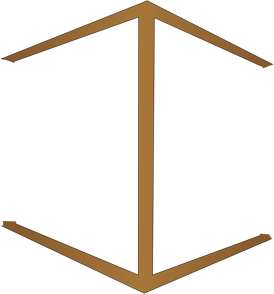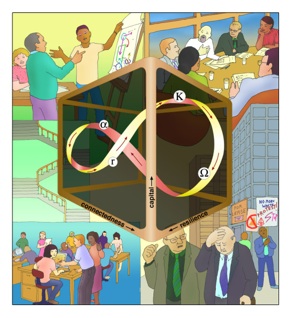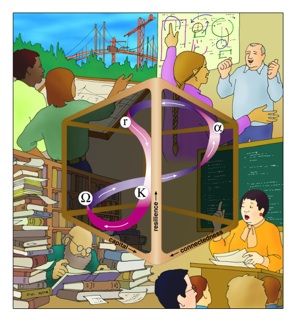Panarchy










the adaptive cycle
Perhaps the most frequently referred to, or popular insight within Holling’s work is the adaptive cycle. Indeed, if one googles “Holling”and looks under “images” the adaptive cycle appears in many versions. This is perhaps because it is so generally relevant! It can offer insight regarding how any complex system evolves, whether an ecosystem, a social system, or even a knowledge generation cycle.
Part of the appeal of Holling’s formulation of the adaptive cycle is the sideways figure 8 with its cultural reference to infinity -- which clearly indicates the inherent endless, ongoing nature of this cycle of creation and collapse. It fits with the ethos of many cultures as humans have struggled to understand why things don’t just keep going as they always have.

a synthesis of ideas
The book, Panarchy, emerged from the thinking of many contributors. The genius of Holling in finding ways to fund and lead collaborative enabled this kind of emergence. He developed the idea of Island Workshops, that is on islands, either literally, or in a way that enabled people to participate together without the concerns of their usual lives interfering.
The prolonged and intense contact also led to a selection of persons who effectively worked together in a space of curiosity and inquiry/ Thus we were invited to a series of week-long workshops over several years to discuss and formulate the ideas that were eventually assembled and guided through an extensive editorial process by Lance Gunderson.


C.S. Holling, Wikimedia commons
appreciation
In the early 1970’s I moved to UBC somewhat reluctantly with my
Ph.D. thesis still incomplete. Shortly after arrival I happened to attend a seminar that changed my life direction. Dr. Holling was presenting some of his early work, and what so inspired me was how his insights offered a new way of conceiving the dynamic patters that happen at multiple scales. Yet he was able to show this in a way that complex dynamics resulted in comprehensible behaviour. He often used the rule of hand, i.e. to communicate well, there had to be three memorable points that were not obscured by too much detail. Hence many photos of him holding up one to three fingers as he emphasizes three points!
There were many different aspects to this work including predator prey dynamics, the myths of nature, adaptive cycle, catastrophe manifolds... and of course ecosystem simulation. At that time Holling was at the Director of the Institute of Animal Resource Ecology, and he had gathered a group of enthusiastic and supportive students and staff.

C.S. Holling in 1970s, excerpt from Ecotrust video


attribution
The work now collectively known as “Panarchy” and “Resilience Studies” entails a community of persons. The founding figure, the inspiration for many of the ideas, is a remarkable human being who claims to think with his belly button - which I see as using his deep intelligence in both logical and systemic thinking.
Dr. C.S. (Buzz) Holling has served in many prestigious capacities, for example he has been the Director of the Institute of Animal Resource Ecology at UBC, Director of the International Institute of Applied Systems Analysis and Chair in Ecological Science, U. Florida. He has been acknowledged through many accolades and prizes including the Volvo Environmental Prize and Order of Canada for his work in ecosystem dynamics, resilience theory, and the linkage between ecological and economic systems. Buzz is also a founding member of the Resilience Alliance, and its open access interdisciplinary journal, Ecology and Society.

mentorship
Buzz was the ultimate mentor. He believed in people and supported them, with the result that they engaged deeply in the community and much insightful work was produced by the group. Thus he was, and still is, exceptionally encouraging and inspirational.
In my innocence in the 70’s and 80’ I was not aware quite how fortunate I was to be included in his group, offer my contributions, and see them incorporated in the work of the group. Of course, in any
co-inspirational process, each person sees his or her ideas as they happen, and feels a sense of authorship; but they are not really individual ideas, they are ideas as they arise through the conversations of the group. Thus, although I feel as if I have had a significant role in introducing the third dimension to the adaptive cycle, I also remember well that it was Buzz who said we need to add “resilience”
to the other two dimensions of connectedness and potential.
the logo on the back of the little man is a question mark entwined with an exclamation mark that was my synthesis of how Buzz thought
changes in understanding
Buzz understood the value of metaphor in enabling new understandings to arise. Thus in challenging our current disparate conceptions of whether “Nature” had a natural balance, or whether “she” was capricious, he introduced the notion of myth. When we have different beliefs than those held in the past, we name the past ones “myths”. Buzz pointed out that our changes in understanding fundamental natural dynamics could also be treated as a set of myths. A synthesis of the myths of nature is presented in the first chapter of the book Panarchy (see below)
This little tail moving away from the cycle after the alpha phase is important. It shows that although the cycle may repeat itself in a form similar to the previous (as for example ecosystem succession) - it can also become reorganized as a different sort of system.
The names on the ribbon (exploitation, conservation, etc.) were the original references to the the four phases from r to K to omega and alpha. The names in the boxes (planning,implementation) etc. were offered as alternatives that correspond better to how this cycle works for human enterprises. The two axes were originally labelled connectedness and capital, but capital is since replaced by “potential”.







linked scales
Work with the actual location-based environmental management issues led to the development of many practically useful notions. Work with the Spruce Budworm in New Brunswick, and the Everglades in Florida helped formulate the notions that led to the notion of nested adaptive systems. Thus a larger system provided the context that enabled a system to re-organize as the same type of system it had been before (remember function). On the other hand, a disruption in a contained or smaller system, could at times lead to a disruption of the system (revolt function).
Furthermore, the discipline of creating computer simulation models further helped the development of ideas that were explicit in terms of both space and time. The notions of bounding presented on this website were articulated by Holling and his group at UBC during the early years of using simulation to assist the development of our understanding of scale and connection.
panarchy
The word “panarchy” which became the title of the book has
a double entendre explicitly in it. First, of course, is the literal meaning based on the Greek roots of “pan” meaning all over, everywhere, and “archy” or rule. Thus the word panarchy specifies that systems are not directed from either above as in a hierarchy, or from below, nor are they chaotic. There is a distributed rule or influence in and among all evolved systems.
Second, it refers to Pan, the Greek god of the vine, of panpipes. Pan was full of music, mischief, and surprise. He personified the unexpected and the playful, both of which are important attributes for human learning and engagement.
wikimedia commons
summary of findings
-
-
1. multi-stable states common in systems
-
2.adaptive cycle fundamental
-
3.not all changes are “adaptive”
-
4.sustainability requires change and persistence
-
5.self-organization provides arena for change
-
6. incremental, lurching, and transforming learning
-
7.the world is lumpy
-
8.functional groups across sizes maintain resilience
-
9.tractability from a “rule of hand”
-
10.systems of humans and nature behave differently than their parts
-
11.management must cope with surprise
-
12.adaptive management outperforms
-




The “three systems” are
abstractions from a systemic network
that we are participants in.
Human participation in the ecosystem is
based on our crisscrossing desires.
It isn’t Science,
its Politics.
Linked ecological / economic / social systems behave fundamentally different than their parts.

linked systems
Work with actual location-based issues also enabled the development of an understanding of how ecology, economics, and social systems were always co-existent and could not be separated from each other:decisions made in one realm always had consequences on the others.
Part of this learning emerged from week-long workshops conducted with stakeholders, researchers, and decisions makers. Here too the discipline and clarity of jointly formulating a simulation model, which was then coded and jointly used to explore policy options, served as a device for the exploration of linkages between systems. Further, it became clear that the implementation of recommendations was highly sensitive to the political realm. Where a project became integrally resolved, there was generally a “grey eminence” involved. This was a respected person of wisdom and integrity who slowly navigated a path of integrated changes among these linked systems.
adding a dimension
There was quite a lot of discussion during the creation of the Panarchy book as to why the back loop has a higher potential before it begins reconstituting the next system. Furthermore, the notion of resilience was becoming more and more obviously relevant, how did this fit in with the adaptive cycle? It seemed clear that a system that had reached the peak of its K phase was vulnerable to breakdown, it seemed to become rigid or brittle, and thus less resilient. Thus the notion of adding a third dimension. Potential remains on the vertical axis, and connectedness and resilience each on the two horizontal axes.





You can probably also imagine a top down view on all of these loops, which then becomes a cycle. Further thinking on my part has led me to a different perspective on the nature of the axes and the dynamics entailed.

Once the adaptive cycle can be shown in 3-D, it becomes clear that the original insightful perspective can be viewed differently by turning the cube. I had to construct a physical model to be able to imagine and draw several different views, and consider how they applied to a) forest succession, b) enterprise, and c) the generation and propagation of knowledge.

forest succession
enterprise or business
knowledge